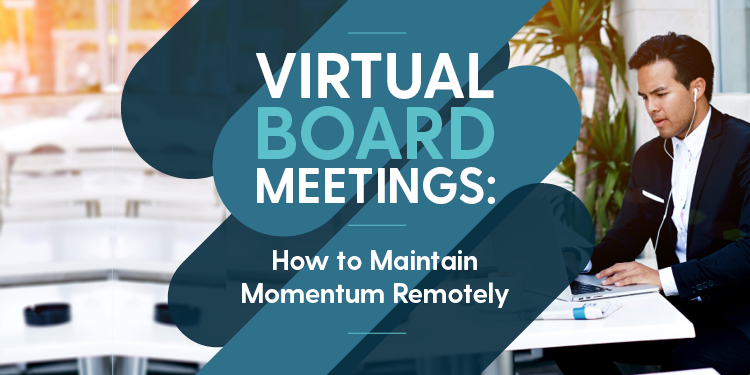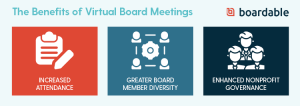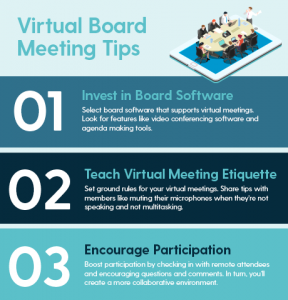
Instead of letting the pandemic impact board functions, many nonprofits have used this as a chance to get creative with their board management strategies and find alternative communication methods. With social distancing guidelines still in place, boards have turned to virtual tactics to handle day-to-day tasks and remain connected while working from home. Among these vital tasks are their routine meetings.
Virtual meetings can be very beneficial for nonprofit boards, so long as there’s a strategy in place for maintaining efficiency and engagement. As your organization’s executive director, it’s up to you to provide your board with the necessary resources for communicating and making critical decisions to facilitate your nonprofit’s work.
As you transition to remote board management, consider how the shift to virtual board meetings would help your team remain connected and maintain momentum despite the distance.
Then as you update your tech strategy, put a special emphasis on tools that allow board members to attend any given meeting from wherever they choose. All they need is an internet connection, and they’ll be able to listen to presentations and reports as well as bring their own insightful ideas to the table.
So you can gauge how virtual meetings will play into your board management strategies, we’ll dive into three core areas with this guide, including:
- Recognize the value of virtual board meetings.
- Understand the challenges of virtual board meetings.
- Implement best practices to pull off successful virtual board meetings.
With a solid understanding of virtual board meetings, you’ll be equipped to conduct productive meetings and maintain momentum while working remotely. Let’s kick things off by talking about the benefits of virtual board meetings.
1. Recognize The Value of Virtual Board Meetings.
Meetings are where your board and committee members let their creativity flow to come up with a strategic plan that guides your organization toward its mission. Shifting to the digital space allows boards to continue valuable conversations regarding the health and vitality of your organization’s work despite the physical distance from one another.
While going virtual is oftentimes a choice, many boards have to host virtual meetings right now. As noted in Boardable’s guide to virtual board meetings, there are several reasons a nonprofit might shift to remote meetings, whether it’s due to expenses, time constraints, or health concerns. Let’s take a closer look at why going digital is a good idea, both during the pandemic and post-pandemic.
Benefit #1: Increased Attendance
Your board members lead busy lives outside of the boardroom. While they may certainly be committed to your cause, life can be a balancing act, which is why it’s always a great idea to accommodate their needs and make their jobs easier when possible.
By allowing board and committee members to attend remotely, many organizations see a boost in attendance, which is an important benefit if you’re struggling to meet quorum. Going virtual eliminates travel expenses and minimizes time commitments for attendees. By valuing their time at this level, they’ll take notice and come much more prepared to participate.
Benefit #2: Greater Board Member Diversity
Moving online vastly expands your participant pool by eliminating geographical barriers. With the expansive technological world, members from across state lines (or across the globe) can join your team. As a result of greater board diversity, new perspectives will lead to insightful ideas, ultimately helping your team make well-rounded decisions.
Not only do virtual meetings break down physical barriers, but they also allow those with accessibility concerns (such as visual or hearing impairments) to participate. Just make sure you’re equipped with board management software that offers accessible audio and video capabilities. That way, board members with any range of accessibility needs can join, making for a much more inclusive environment!
Benefit #3: Enhanced Nonprofit Governance
Turning to technological communications empowers the chair and other leaders to leverage strong and thorough governance. Doing so allows the chair to maintain control over meeting discussions and make time-sensitive decisions despite the distance. Plus, according to re:Charity, open communication is vital to maintain relationships, keep track of progress, and reach organizational goals.
Your board management tools will help immensely at this stage by providing a platform to communicate and record decisions over a range of devices. When updating your tech strategy, features such as polling capabilities, record-keeping tools, and agenda-making tools will ultimately lead to timely decision-making and collaborative discussions. This way, your board can focus on having important conversations instead of struggling to communicate remotely.
2. Understand The Challenges of Virtual Board Meetings.
As with any strategy, remote board meetings do have their pitfalls and challenges. Instead of letting these hindrances deter you, take the time to fully understand them, so you can strategize ways to overcome them. Let’s explore three areas where you might initially struggle as you figure out your game plan.
Challenge #1: Information Security
Nonprofit boards have private discussions regarding the nonprofit’s strategic direction and financial stability. Unfortunately, in the case of virtual meetings, technology naturally poses a risk to this information security. In turn, board members may be reluctant to share sensitive information or discuss controversial issues using digital means.
Luckily, this is an easy fix. Mitigate cybersecurity risks by ensuring your virtual meeting platform is fully secure. Look for a system that uses secure sockets layer (SSL) certification, which encrypts data. This way, you can safely transmit documents and have confidential discussions without concern.
Challenge #2: Reduced Engagement
With a lack of face-to-face interaction, you risk board members’ engagement by going remote. To be effective, individuals need to participate wholeheartedly. Even when only some members are remote, those who phone-in usually only listen and vote on motions, which poses an inherent risk to productivity. A meeting where members passively listen won’t help your nonprofit accomplish its mission.
The quick and easy fix is to incorporate video chatting. In this guide to working from home, re:Charity states:
“Scheduling video calls is a great way to retain a sense of normalcy from your in-person relationships as they transition to remote versions. Being able to see the person on the other line adds an extra layer of togetherness…that traditional phone calls cannot.”
With video conferencing, remote attendees can gauge others’ body language and tap into nonverbal cues that they would miss by only speaking over the phone. This can ultimately reignite their engagement and promote a spirit of inclusion.
Challenge #3: Technological Reliance
According to this resource, adopting new technology often comes with many challenges. For one, organizers must be hyper-aware of the technological requirements, ensuring that both leadership and board members have access to sufficient technology to attend. Plus, your less-tech-savvy board members may be reluctant to try out new digital platforms.
Overcome learning curves by supplying members with user-friendly conferencing tools that make the switch to a virtual platform as seamless as possible. Consider also providing attendees with comprehensive instructions on how to join and participate in polls and discussions. You might designate a point-of-contact at your organization to mitigate any technical issues that arise.
3. Implement Best Practices to Pull Off Successful Virtual Board Meetings.
Understanding the benefits and challenges of digital meetings isn’t enough to create a collaborative and engaging environment. Conducting successful meetings requires a strategy that’s rooted in best practices. Let’s review three tips you should implement to make the most of your time in the virtual boardroom.
Tip #1: Invest in virtual board software.
According to re:Charity’s list of COVID-19 fundraising resources, dedicated board software will centralize communication and drive productivity, so your team can stay on track despite social distancing. When you invest in this specific solution, you can improve communication, increase productivity, and equip your board to make time-sensitive decisions.
Dedicated board software will handle the legwork by streamlining tedious tasks, so your board members can reinvest their time into strategic discussions surrounding your mission. However, don’t just invest in any board software. Instead, look for a solution that will support your specific needs and efforts with features like:
- Agenda making tools. Your agendas are the driving force of your meetings. According to Boardable’s board meeting agenda guide, the right board software will allow you to customize your agendas and securely share them as an interactive PDF before your meetings so that members can come prepared with thoughtful input.
- Built-in video conferencing software. As we mentioned, incorporating video into your virtual meetings drives engagement and allows members to tap into important nonverbal cues. Some board software comes equipped with video conferencing tools, so you can create a much more meaningful experience for meeting attendees.
- Task management tools. Outside of the digital boardroom, your board members will need to complete important tasks to drive the nonprofit’s success. Delegate duties directly within your board portal (or attach tasks to specific meetings). Each member should be able to see their assigned duties and due dates on their home dashboard, so they can come prepared for the next meeting.
It’s no secret that remote operations require more of a hands-on approach. Virtual nonprofit board software will empower your board leadership to enhance governance and make powerful strides toward its goals. Remember to go the extra mile to make sure your board adopts these new tools efficiently by providing sufficient instructions and support.
Tip #2: Brush members up on virtual meeting etiquette.
In any new environment, it’s important to take time to outline expectations and set guidelines upfront. Especially with completely remote meetings, good etiquette is more important than ever.
As you begin laying the groundwork for your virtual meetings, consider these suggestions and proactively communicate them to board and committee members:
- Mute the microphone. At the start of each meeting, remind participants that it’s polite to mute their microphones when they’re not speaking, especially if they have noisy backgrounds with excited children running amuck.
- Don’t multitask. While it’s easy to get distracted during virtual meetings, distractions are detrimental to productivity. Encourage attendees to close out any irrelevant windows and eliminate distractions prior to the meeting.
- Review the protocol for discussions. Prior to starting the meeting, let attendees know how you’d like them to participate. Will they need to raise their hands and be acknowledged by the chair? Or are they allowed to jump in whenever they have a point to add? Set these guidelines upfront to encourage smooth discussions with minimal unanticipated interruptions.
Setting these ground rules in advance will help to avoid confusion and a chaotic meeting environment. Otherwise, you may catch your board members surfing the web, talking over one another, or zoning out altogether.
Tip #3: Encourage participation.
You’ve placed your board members in a position of power because you value the insights and skills they bring to the table. Like we discussed earlier, going virtual poses an inherent threat to attendees’ engagement. Combat this challenge and keep everyone involved by leveraging these tactics:
- Have everyone speak at the beginning of the meeting. Establishing a culture of collaboration from the start will get everyone comfortable speaking in the virtual setting. Start a short conversation that’s applicable to everyone, such as how their week is going or what they’ve been watching on television.
- Check in with remote attendees during the meeting. When only a few attendees are remote, it can be difficult for them to interject and hop into the discussion. Pause after each topic and ask everyone to offer their thoughts.
- Encourage comments and questions throughout the meeting. When attendees hold their input until the very end, they’ll likely forget. Advise them to voice their thoughts as you go, and this can spark a collaborative discussion!
Without proactively developing an inclusive environment, you may lose your remote attendees’ attention. When left to be passive observers, they’ll most likely tune out altogether, wasting everyone’s time and leaving your nonprofit without their much-needed guidance.
Many nonprofit operations have shifted online, including crucial board interactions. Virtual meetings can be a very powerful tool, but only if you go into it with sufficient background knowledge.
Prior to kicking off your virtual strategy, make sure you’re well-versed in the advantages and challenges of going remote, as well as best practices for making the most of your virtual boardroom. Backed by this knowledge, you can head into your next meeting with confidence. Just make sure to invest in the right board software with built-in communications technology to get you there. Good luck!


